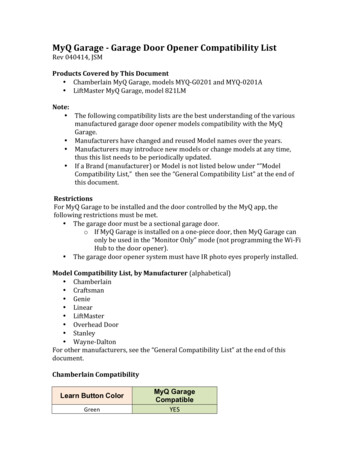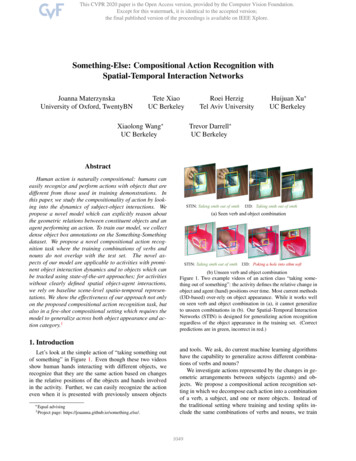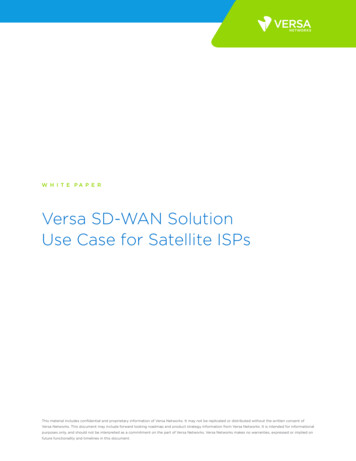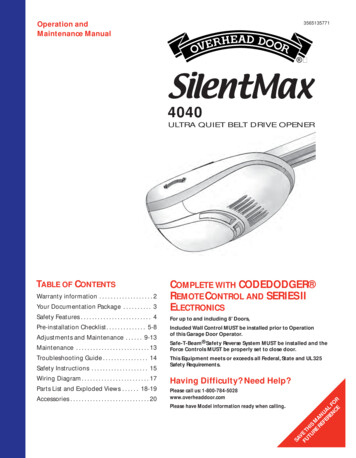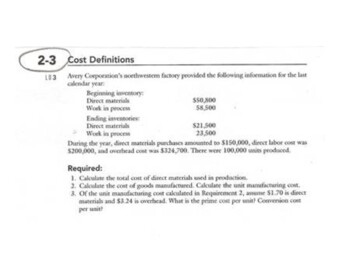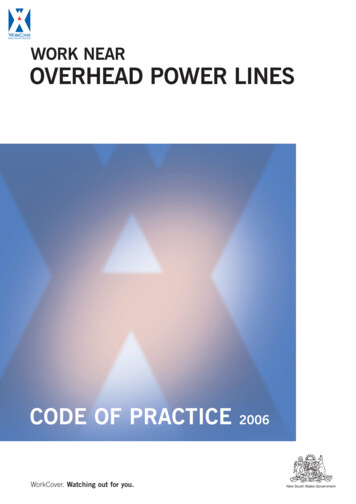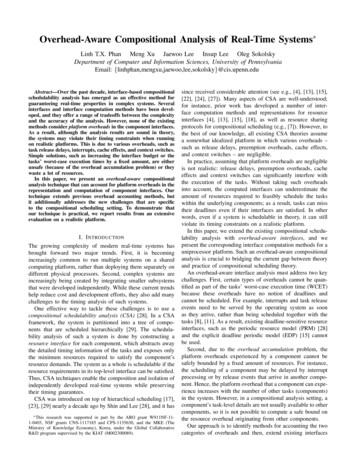
Transcription
Overhead-Aware Compositional Analysis of Real-Time Systems Linh T.X. Phan Meng Xu Jaewoo Lee Insup Lee Oleg SokolskyDepartment of Computer and Information Sciences, University of PennsylvaniaEmail: uAbstract—Over the past decade, interface-based compositionalschedulability analysis has emerged as an effective method forguaranteeing real-time properties in complex systems. Severalinterfaces and interface computation methods have been developed, and they offer a range of tradeoffs between the complexityand the accuracy of the analysis. However, none of the existingmethods consider platform overheads in the component interfaces.As a result, although the analysis results are sound in theory,the systems may violate their timing constraints when runningon realistic platforms. This is due to various overheads, such astask release delays, interrupts, cache effects, and context switches.Simple solutions, such as increasing the interface budget or thetasks’ worst-case execution times by a fixed amount, are eitherunsafe (because of the overhead accumulation problem) or theywaste a lot of resources.In this paper, we present an overhead-aware compositionalanalysis technique that can account for platform overheads in therepresentation and computation of component interfaces. Ourtechnique extends previous overhead accounting methods, butit additionally addresses the new challenges that are specificto the compositional scheduling setting. To demonstrate thatour technique is practical, we report results from an extensiveevaluation on a realistic platform.I. I NTRODUCTIONThe growing complexity of modern real-time systems hasbrought forward two major trends. First, it is becomingincreasingly common to run multiple systems on a sharedcomputing platform, rather than deploying them separately ondifferent physical processors. Second, complex systems areincreasingly being created by integrating smaller subsystemsthat were developed independently. While these current trendshelp reduce cost and development efforts, they also add manychallenges to the timing analysis of such systems.One effective way to tackle these challenges is to use acompositional schedulability analysis (CSA) [28]. In a CSAframework, the system is partitioned into a tree of components that are scheduled hierarchically [29]. The schedulability analysis of such a system is done by constructing aresource interface for each component, which abstracts awaythe detailed timing information of the tasks and exposes onlythe minimum resources required to satisfy the component’sresource demands. The system as a whole is schedulable if theresource requirements in its top-level interface can be satisfied.Thus, CSA techniques enable the composition and isolation ofindependently developed real-time systems while preservingtheir timing guarantees.CSA was introduced on top of hierarchical scheduling [17],[23], [29] nearly a decade ago by Shin and Lee [28], and it has This research was supported in part by the ARO grant W911NF-111-0403, NSF grants CNS-1117185 and CPS-1135630, and the MKE (TheMinistry of Knowledge Economy), Korea, under the Global CollaborativeR&D program supervised by the KIAT (M002300089).since received considerable attention (see e.g., [4], [13], [15],[22], [24], [27]). Many aspects of CSA are well-understood;for instance, prior work has developed a number of interface computation methods and representations for resourceinterfaces [4], [13], [15], [18], as well as resource sharingprotocols for compositional scheduling (e.g., [7]). However, tothe best of our knowledge, all existing CSA theories assumea somewhat idealized platform in which various overheads –such as release delays, preemption overheads, cache effects,and context switches – are negligible.In practice, assuming that platform overheads are negligibleis not realistic: release delays, preemption overheads, cacheeffects and context switches can significantly interfere withthe execution of the tasks. Without taking such overheadsinto account, the computed interfaces can underestimate theamount of resources required to feasibly schedule the taskswithin the underlying components; as a result, tasks can misstheir deadlines even if their interfaces are satisfied. In otherwords, even if a system is schedulable in theory, it can stillviolate its timing constraints on a realistic platform.In this paper, we extend the existing compositional schedulability analysis with overhead-aware interfaces, and wepresent the corresponding interface computation methods for auniprocessor platform. Such an overhead-aware compositionalanalysis is crucial to bridging the current gap between theoryand practice of compositional scheduling theory.An overhead-aware interface analysis must address two keychallenges. First, certain types of overheads cannot be quantified as part of the tasks’ worst-case execution time (WCET)because these overheads have no notion of deadlines andcannot be scheduled. For example, interrupts and task releaseevents need to be served by the operating system as soonas they arrive, rather than being scheduled together with thetasks [8], [11]. As a result, existing deadline-sensitive resourceinterfaces, such as the periodic resource model (PRM) [28]and the explicit deadline periodic model (EDP) [15] cannotbe used.Second, due to the overhead accumulation problem, theplatform overheads experienced by a component cannot besafely bounded by a fixed amount of resources. For instance,the scheduling of a component may be delayed by interruptprocessing or by release events that arrive in another component. Hence, the platform overhead that a component can experience increases with the number of other tasks (components)in the system. However, in a compositional analysis setting, acomponent’s task-level details are not usually available to othercomponents, so it is not possible to compute a safe bound onthe resource overhead originating from other components.Our approach is to identify methods for accounting the twocategories of overheads and then, extend existing interfaces
to encapsulate the overheads that cannot be included in thetasks’ WCETs. The first category consists of all overheadsthat can be included as part of the tasks’ WCETs, such ascache effects and context switches; these can be capturedtogether with tasks’ resource demands by a traditionalresource model, such as PRM or EDP. The second categoryconsists of the overheads that cannot be included as part ofthe tasks’ WCETs, such as interrupt overheads and releasedelays; these are captured using the deadline-insensitiverequest bound function [25]. By separating these twocategories, our interface representation not only leveragesthe existing compositional analysis results but also enablesthe computation of inter-component overheads during theinterface composition; thus, we can overcome the overheadaccumulation problem.Contributions. This paper makes the following contributions: We discuss the overhead accumulation problem and theinsufficiency of the WCET inflation method (Section III). We present a compositional overhead account method(Section IV) and introduce an overhead-aware schedulability test for components (Section V). We propose an overhead-aware representation for component interfaces and the corresponding interface computation method (Section VI). We illustrate the applicability and benefits of overheadaware analysis with an extensive evaluation of randomlygenerated workloads on a realistic platform. The evaluation results show that the computed interfaces aresafe in practice, and that they can help reduce resourcebandwidth up to a factor of five compared to a baselineapproach which inflates tasks’ WCETs. (Section VII).bandwidth among all EDPs that can feasibly schedule the taskswithin the component.The amount of the resource provided by a resource modelR is captured by the supply bound function of R, denotedby sbf R (t), which specifies the minimum number of resourceunits that R is guaranteed to provide over any time interval oflength t, for (all t 0. The SBF of an EDP is given by [15]:y max 0, t x y , if t sbf (t) 0,otherwise(1)where x 2 and y b t ( ) c. We call xthe blackout interval of . We note that an SBF can also beused as a resource interface; in which case, the supply boundfunction of an SBF is the SBF itself.Schedulability analysis without platform overheads. LetC be a component with a workload { 1 , 2 , · · · , n },where i (pi , ei , di ) is either a periodic task or an EDPinterface of a subcomponent of C. The request bound function(RBF) of i is given by rbf i (t) d pti eei for all 1 i n.Under a fixed-priority (FP) scheduling algorithm, such as RateMonotonic (RM) or Deadline Monotonic (DM), the RBF ofthe i highest-priority tasks of C is given by [21]:Xrbf C,i (t) rbf k (t), 81 i n,II. BACKGROUNDThis section describes the system model and the backgroundrequired for our analysis in the coming sections.System model. The system consists of a tree of componentsthat are scheduled hierarchically. Each internal vertex ofthe tree represents a composite component, whose childrenare its sub-components. Each leaf represents an elementarycomponent, which is a finite set of tasks in the system. Eachcomponent has its own scheduler, such as Earliest DeadlineFirst (EDF) or Rate Monotonic (RM), that schedules its subcomponents (tasks). All tasks are periodic tasks with explicithard deadlines. Each task i is defined by i (pi , ei , di ),where pi is the period, ei is the WCET, di is the relativedeadline, and 0 ei di pi .Resource models. We use the explicit deadline resourcemodel (EDP) for part of our interface representation becauseit is simple and offers a good tradeoff between accuracy andefficiency. (However, our method can easily be incorporatedinto other resource models in a similar fashion.) An EDPis defined by ( , , ), where is the period, isthe budget, andis the deadline. This represents a resourcesupply that provides units of resources within time units,with this pattern repeating every time units. The bandwidthof the EDP is defined by / . We say that an EDP is(bandwidth) optimal for a component iff it has the smallestLemma 1. A component C is schedulable under an FPscheduling algorithm by a resource model R iff8 1 i n, 9t 2 [0, di ] s.t. sbf R (t) rbf C,i (t).(2)1 k iwhere i has higher priority than j if i j. Under EDF, thedemand bound function (DBF) of C is given by: n jXt pi d i kdbf C (t) ei .pii 1The next two lemmas state the schedulability condition of C,assuming no resource overheads [15]:Lemma 2. A component C is schedulable under EDF by aresource model R iff sbf R (t) dbf C (t) for all 0 t LCM,where LCM is the least common multiple of pi for all i in C.Based on the above schedulability tests, an EDP interface ofa component can be computed efficiently using the algorithmsproposed in [15]. Due to space constraints, we refer the readersto [15] for the details.III. M OTIVATING EXAMPLENext, we present an example that illustrates the overheadaccumulation problem and the issues that can arise withexisting compositional analysis methods in practice whenplatform overheads are neglected. For this example, we focuson task release interference.Real-time jobs are typically released using timer interrupts(for periodic tasks) or other interrupt routines (for aperiodictasks) [11]. We use the term release ISR to denote theprocessing of an interrupt service routine that releases a job.On a realistic platform, such release ISRs take non-zero timeand need to be serviced by the kernel as soon as they arrive [8],[11].
Example of invalid analysis results due to overhead.Consider a component Croot that has two subcomponents, C1and C2 , where C1 has the workload { 1 } and C2 has theworkload { 2 , . . . , 51 }. All components schedule their tasks(subcomponents) under EDF. The timing parameters of thetasks are 1 (5, 4, 5) and 2 · · · 51 (500, 1, 500),where the time unit is milliseconds (ms). Each release ISRtakes up to 0.020 ms, which is a typical value in practice [11].By applying the existing interface computation techniquesfor EDP (c.f. Section II), we obtain the interfaces I1 (5, 4, 5), I2 {10, 1, 10} and Iroot {5, 4.5, 5}. Since thebandwidth of Iroot is 0.9, this system is deemed to be schedulable. However, in practice this system is not schedulablebecause of the scenario shown in Fig. 1.deadline missedcomponent C1τ1component C2τ2τ1.τ51ISR1 . ISR51.release ISRs0123456Fig. 1: A counterexample for the schedulability of Croot .In this scenario, the ideal release times of 1 and 2 are0, and each i is ideally released 0.001 ms after i 1 for alli 2. In this case, although 1 is effectively released at time0.020, it has to wait for the system to finish processing allthe release ISRs in the second component. As a result, it canonly start its execution at time 1.020 and finish at time 5.020.Hence, 1 misses its deadline.Why is WCET inflation not sufficient? Intuitively, it mayseem that a simple solution is to inflate the WCETs of eachtask by the execution time of one release ISR. However,even with inflated WCETs, the above system is still deemedschedulable by the analysis. Inflation is unsafe because it doesnot account for the release interference by other tasks’ releaseISRs: for instance, the task 1 in Fig. 1 is delayed by therelease ISRs of all the other tasks in the system. Even if weinflate the task WCET by the total execution time of all therelease ISRs, we may still underestimate the resource needsbecause a job of a task i may be delayed by multiple releaseISRs of multiple jobs of j if pi is much larger than pj . Wealso observe that the release interference overheads accumulateas the number of tasks in system increases.It would be safe to inflate the WCET of each task by the total execution time of all release ISRs that can delay that task’sexecution; however, this cannot be done in the compositionalsetting. In this setting, the timing information of the taskswithin one component is unavailable to the other components;thus, the tasks’ WCETs and the components’ interfaces wouldneed to be recomputed as more tasks (components) are addedinto the system. This is not possible with current CSA methodsbecause the interfaces do not contain any task-level detailsor information about overhead. Recomputing the interfaces ofcomponents at all levels of the scheduling hierarchy is notdesirable because it increases the complexity of the analysisand diminishes the efficiency benefits of CSA.IV. OVERHEAD ACCOUNTINGIn this section, we first identify the different types of platformoverheads, and then we show how to overcome the problemthat was described in the previous section.A. OverviewThe overheads that a job may experience during its lifetimeinclude the following:rel Release ISR (): The maximum time needed to adda released job to the ready queue;sch Schedule function (): The maximum time the scheduler needs to select the highest-priority job to execute;cxs Context switch (): The maximum time the processorneeds to switch from one job to another.CRPD Cache-related preemption ( i): The maximum timeneeded to recover the cache affinity of a job after it hasbeen preempted by a task i . (When a job resumes itsexecution after being preempted, some or all cache blocksof its working set may have been evicted from cache andmay need to be reloaded to recover the cache affinity.)tick Tick (, ptick ): The maximum time needed to executethe tick function, which is invoked with period ptick . Other interrupts: Time needed to handle other types ofinterrupts, e.g., network interrupts.Types of overheads. We group the overheads that affect atask’s response time in a compositional scheduling system intotwo categories. The first category consists of overheads thatcannot be accounted for by inflating the tasks’ WCETs. Itincludes the release interference overheads, i.e., the overheada task experiences due to the execution of release ISRs, andoverheads due to other interrupts. In this paper, we consideronly the release interference overheads, but other types ofinterrupts can be accounted for in a similar way, provided thattheir worst-case execution times and a bound on the numberof interrupts are known. The second category consists of theremaining types of overheads, which can be accounted for byinflating the tasks’ WCETs. We call them inflatable overheads.In the following, we describe our method for accountinginflatable overheads. Non-inflatable overhead accounting willbe discussed in Section VI.B. Accounting for inflatable overheadsTo account for inflatable overheads, we extend the accountingtechnique proposed by Brandenburg et al. [11] for use withcompositional scheduling. The original method from [11]cannot be applied directly for two reasons: First, it assumesthat the number of tasks in the entire system is known a priori;as was discussed earlier, this is not the case in our settingbecause a component has no knowledge of other components.Second, the original method assumes a constant bound CRPDon the cache-related preemption overhead for each task. This isunsafe in the compositional analysis setting because the cacherelated preemption delay of each task depends on its workingset size and preemption points, which can change when tasksor components are added to, or removed from, the system.We extend the method from [11] in two ways: we accountfor the release interference separately (c.f. Section VI),
rather than simply inflating the WCET, and we introduce amethod for quantifying the cache-related preemption overhead(CRPD) of each task, which can be done independently ofother tasks. Below, we first describe how inflatable overheadscan be quantified based on the events that cause them.Inflated WCET. Based on the above equations, the inflatedWCET of a task i can be computed by:ei relEv preEve0i deptick(7)tickptickV. OVERHEAD - AWARE S CHEDULABILITY A NALYSIS OFC OMPONENTSInthissection,weextendthe existing component schedulabilCPUity analysis (see Lemmas 1 and 2) to account for the platform!rel!sch!cxsei!sch!cxs!CRPDeioverheads a component may experience. We first present theschedulability analysis in the presence of inflatable ioneventrelatedoverhead.(a) Overhead related to a release event(b) Overhead related to a preemption eventonly, and then we introduce our method for capturing theFig. 2: Overheads related to release and preemption events.release interference overheads.In the following, we consider a component C h , AiOverhead related to release events. The timeline of a task’switha workload { 1 , . . . , n } and scheduling algorithmrelease event is illustrated in Fig. 2(a). i ’s overhead includesA,whereeach i (pi , ei , di , ) is a periodic task (or a taskits own release overhead, scheduling overhead, and contextcorrespondingto an interface of a subcomponent of C). Let e0iswitch overhead. Although it is possible to include i ’s ownrelease ISRs as part of this overhead, this leads to a pessimistic be the inflated WCET of i , which is computed using Eq. (7).00000analysis because we need to include it in the (non-inflatable) Further, let { 1 , . . . , n }, where i (pi , ei , di ). We00release-interference overhead as well. Hence, we only account call the inflated workload of C. Recall that ei includesfor the scheduling and the context switch here; thus, the the overheads due to the inflatable overheads, which includeoverheads caused by release events, preemption events andoverhead related to release events is:relEvschcxs (3) ticks (c.f. Section IV).This overhead is included once in each job’s WCET (since Lemma 3. (Inflatable Overhead-Aware Schedulability Test)A component C h , Ai is schedulable by a resource R inevery job is released exactly once).presence of inflatable overheads if its inflated workload 0 isOverhead related to preemption events. This overhead is schedulable by R under A when there are zero overheads.illustrated in Fig. 2(b). When a preemption happens, we referProof: The lemma is established based on the overheadto the higher-priority task i as the preempting task and to thelower-priority task j as the preempted task. When i finishes accounting technique in Section IV. Recall that the inflated0relEv,its execution, the scheduler is invoked to resume j , which WCET, ei , is computed based on the maximum valuespreEvtickandof the overheads caused by release events,results in a scheduling overhead and a context switch. Further,the system needs to reload any cache blocks of j that have preemption events and ticks for each i , respectively.Therefore, the total execution time of i in presence ofbeen evicted from the cache during the execution of i , which0results in a cache-related preemption overhead. Since a job of these overheads is no more than ei . Hence, we imply that0 i only preempts j exactly once, we include the preemption- if i is schedulable under A by the resource R assuming zerorelated overhead into the WCET of i ; the overhead can be overheads, then i is also schedulable under the overheadscaused by the release events, preemption events and ticks.computed as: is schedulable in presence of inflatablepreEvschcxsCRPDi (4) In other words,overheads if 0 is schedulable assuming zero overheads.The CRPD overhead of i can be quantified based on the Release interference overhead. Recall that release interferevicting cache block (ECB) of i . Here, a memory cache ence overhead is the delay a task experiences due to theblock is called an ECB of i if it can be accessed during the execution of the release ISRs of the tasks in the system.execution of i [1]. Let BRT be the time needed to reload oneThese release ISRs have thecache block from the main memory to the cache, and ECBi highest priority, and thus they canFPbe the number of evicting cache blocks of i . Then, the CRPD delay the execution of any taskoverhead can be bounded based solely on i as below.in the system. When multiple reCRPDi BRT ECBi (5) lease ISRs arrive at the same time,EDFreleasethesystemexecutesthemonebyISRsNote that the above bound can be determined separately1higher-priority lower-priorityfor each task i , so it can be used within a compositional one in an arbitrary order.Our approach is to capture theanalysis, where the details of tasks in other components areexecutionof the release ISRs and Fig. 3: Modeling releasenot known a priori.the execution of the workload interference overheads.Tick overhead. Due to the execution of the tick function, the of a component C using a compositional scheduling analogy.system loses tick time units every ptick time units. Thus, As is illustrated in Fig. 3, the release ISRs can be seen asthe effective WCET of each task i with a given WCET ei , the workload within a higher-priority component, and thewithout considering other types of overheads, is given by [9]: workload forms the lower-priority component. The system’seie0i deptick(6)1 This is the case for most common platforms [9]. Note that although sometickptickτsystems, e.g., LITMUS [12], execute release ISRs that arrive at the same timein group, the worst-case interference still occur when the release ISRs arrivean epsilon time one after another.
resources are always allocated to the release ISR componentbefore they are given to the workload component. Within theworkload component, the tasks are scheduled as usual by C’sscheduler, e.g., EDF in Fig. 3.Based on the above modeling approach, we can determinethe total release interference overheads a componentexperiences due to the release ISRs of its tasks basedon the resource requests of these ISRs. We call this theintra-component release interference overhead.Lemma 4. The intra-component release interference overheadof a workload is bounded by the resource request boundfunction (RBF) of the release ISRs of the tasks in , given byXtISRrbf ISRrbf ISRe rel , (t) i (t), with rbf i (t) dpi 2 iwhererelis the maximum execution time of a release ISR.Proof: Since every job release creates one release ISR, themaximum number of release ISRs of task i over any intervalof length t is d pti e. Since each release ISR requires a maximumof rel execution time units, the total amount of resourcestrelrequested by the release ISRs of i is rbf ISR. i (t) d pi eAs a result, the total amount of resources requested by therelease ISRs ofPall tasks in over an interval of length ISRis rbf ISR (t) i 2 rbf i (t). Since the release ISRs havehigher priority than any other task in the component, rbf ISR (t)is also the resource interference that the tasks in experiencedue to their release ISRs. This proves the lemma.The next two lemmas state the schedulability analysis for acomponent considering release interference overheads.Lemma 5. (Release Interference-Aware Schedulability Test)A component C h , Ai is schedulable by a resource R inpresence of intra-component release interference overhead ifit is schedulable by a resource R0 in the absence of overhead,where R0 has a supply bound function equal todefsbf R0 (t) sbf remsbf R (t0 )R, (t) max00 t t0rbf ISR (t ) .Proof: Since the resource provided by R is first given to therelease ISRs, the amount of resources available for executing is the remaining amount of resources after processing allthe release ISRs. From Lemma 4, the amount of resourcesrequested by the release ISRs over any interval of length t isat most rbf ISR (t). Therefore, after processing the ISRs overany interval of length t, there are at least sbf R (t) rbf ISR (t)resources remaining. In addition, the amount of remainingresources over any interval of length t is always larger than, orequal to, the amount of remaining resources over an interval oflength t0 , for all 0 t0 t. Hence, sbf remR, (t) is the minimumremaining resource after processing the release ISRs over aninterval of length t, which is also the amount of resourcesavailable to the tasks over an interval of length t. Thus,the tasks in are scheduled in presence of intra-componentrelease interference overheads if they are schedulable by aresource R0 with a supply bound function equal to sbf remR, (t)when assuming no overheads.The next corollary follows directly from Lemma 5 and theanalysis under zero overheads in Lemmas 1 and 2.Corollary 6. The release interference-aware schedulabilityconditions for a component with workload using a resourceR for EDF and FP are given as follows.rem FP: 8 1 i n 9t 2 [0, di ] s.t. sbf R, (t)rbf C,i (t).rem EDF: 8 0 t LCM , sbf R, (t)dbf C (t), whereLCM is the least common multiple of pi for all i 2 .The overhead-aware schedulability analysis can now be derived based on the inflatable overhead-aware analysis and therelease interference-aware test, which is given by Theorem 7.This theorem is a direct result of Lemmas 3 and 5.Theorem 7. (Overhead-aware Schedulability Test) A component C h , Ai is schedulable by a resource R in thepresence of platform overheads if the inflated workload 0is schedulable under A by a resource R0 in the absence ofoverheads, where the SBF of R0 is equal to sbf remR, (t).VI. OVERHEAD - AWARE I NTERFACES AND I NTERFACEC OMPUTATIONThis section describes our proposed compositional analysismethod, which is based on the overhead-aware schedulabilitytests from the previous section. We begin by discussingthe ISR amortization problem in deadline-sensitive interfacemodels, such as EDP and PRM, which necessitates a newrepresentation and computation method for the interface.A. Challenge: ISR amortization problemBased on the component overhead-aware schedulability testin Section V, it may seem possible to use an existing resourcemodel, such as the EDP or the PRM model, to encapsulatethe total resource requirements of both the tasks and theiroverheads. Alternatively, one could try to capture the releaseinterference overhead (e.g., the release ISRs in Fig. 3) with aseparate EDP or PRM model. However, using such resourcemodels to capture the release interference overhead is unsafe,as illustrated by the following example.ISR amortization under deadline-sensitive interfaces. Consider a component C with a workload 1 (5, 4, 5); 2 · · · 51 (500, 1, 500) , which is scheduledunder EDF. Let rel 0.02. (All times are in ms.) In thisexample, we consider only the release ISRs and assume thatthere are no other types of overheads.By Corollary 6, the above component is unschedulable bya fully available processor (i.e., sbf R (t) t) in presenceof release interference overheads. (Note that the worst-caseresponse time of 1 is 5.020, since it incurs a maximum releaseinterference overhead of 51 0.020 1.02 ms.) However,if we abstract each of the tasks’ resource demands and theintra-component release interference overheads into an EDP,we obtain (5, 4.5, 4.5) and ISR (1, 0.006, 1). Sincethese two interfaces are schedulable under FP, the system isdeemed schedulable, which is incorrect. The same situationhappens if we use other deadline-sensitive resource interfaces,such as PRM or SBF.The flaw in the above analysis based on EDP abstractioncomes from the ISR amortization, which is caused by the
interface deadline. When all release ISRs are invoked at t 0,they are executed immediately and will keep the processorbusy until t 0.02 51 1.02. However, when the resourcesrequested by the release ISRs (captured by rbf ISR(t) in Lemma 4) are encapsulated in an EDP model, the request isamortized to 0.006 time units that need to be completed withinevery time unit. This effectively enables the processor toexecute the jobs in that have been effectively released. Sincetasks do not experience the full release interference overhead,they still make
lability analysis with overhead-aware interfaces, and we present the corresponding interface computation methods for a uniprocessor platform. Such an overhead-aware compositional analysis is crucial to bridging the current gap between theory and practice of compositional scheduling theory. An overhead-aware interface analysis must address two key
